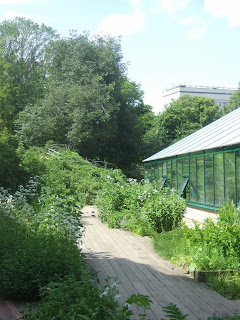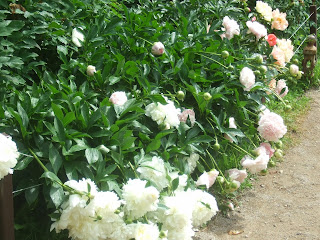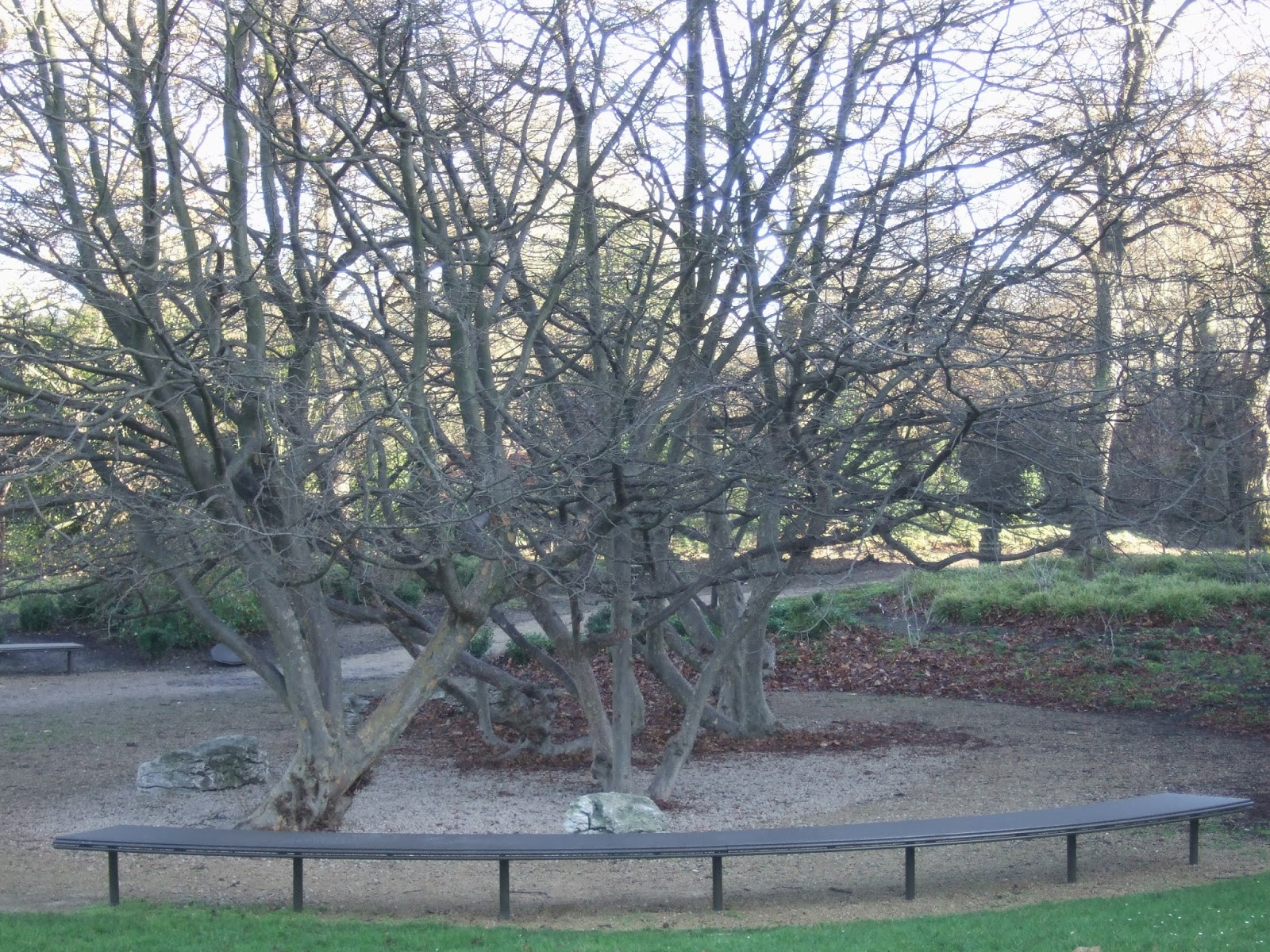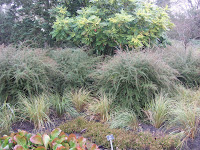In 1706, when the Great Northern War was in its first phases and fearing a Swedish invasion, works to build new fortifications and to strengthen the existing walls interested the Kremlin. In this period, by order of Peter I, the Apothecary Garden, created "during the reign of Ivan IV ... and planted with fruit trees and bushes and aromatic and medicinal herbs,"(1) was moved from the Kremlin wall to this area, at that time, in the outskirts of the town. The Garden was administrated by the Apothecary Order, founded in 1620 to control the Kremlin Pharmacy, the first pharmacy open in Moscow in 1582 for the exclusive use of the Tsar and his family. The Order was also in charge for the provision of medicines. Holland, Germany and England were important suppliers of drugs but also of doctors, surgeons, apothecaries and other specialists, who greatly contributed to the development of medicine in Russia.
Flowers, berries and roots reached Moscow even from the surrounding region and from further North, according to a planned system of harvesting organized by the Order and regulated by royal decrees (licorice came from Voronezh, juniper berries from Kostroma, black hellebore roots from Kolomna, lady's thumb from Kazan, St. John wort from Tobolsk in Siberia as moss, birch sap and cranberries). Apothecary gardens were another important source of medicinal plants, especially of those not easily available. At the end of the XVII century, there were three apothecary gardens in Moscow where plants were cultivated and processed into medicines, oils, ointments and drugs. In addition, in the 'Tsar' Apothecary Garden, medicinal plants were used to teach botany to future doctors and pharmacists. Gardeners and botanists were entrusted with the care of the Garden. Botanists, in particular, more interested in the creation of plant collections and in the study of the local flora, were extremely active, organizing botanical expeditions around Moscow, writing manuscripts about their studies, and creating a herbarium.

The Garden had a regular scheme, with straight large avenues planted with lindens and elms, and neat, geometrical beds with herbs and flowers. There was a rectangular pond for watering and a wooden greenhouse. The garden was not open to the public but
"..[it] was unusually beautiful. In different times of the year, visitors could admire poppies and peonies, hollyhocks and roses, wild roses and jasmine. During the warmer months, plants in pots were exposed - agave, oleander, bitter orange - melons and watermelons ripened in greenhouses. Many plants got here from ancient royal gardens in Moscow, primarily from the famous Izmailovo Garden, planted by Alexis in 1666."(2)
 |
| Map of the Apothecary Garden, 1807 |
The pond lost its geometrical shape for more irregular edges, as the new fashion for the English landscape gardens required. Around 1850,
"[the] old alleys were preserved but most of the territory 'is decorated in English style' ...; [there were] sloping lawns on which 'picturesque groups of trees and shrubs [were] located', 'for the convenience of visitors benches and sofas were instructed in different places.' A substantial part of the ensemble, 'which is assigned exclusively to science' remained regular."(3)
 The black and white portraits of the Directors of the Garden in the following decades, all with beards and mustaches, show serious and competent professors, who further promoted the success of the Garden in Russia and abroad. The new two-storey stone laboratory allowed to carry out scientific researches all year round. The Department of Botany promoted extended studies of the Russian flora, and new modern heating systems was introduced in the greenhouses. By the end of the XIX century, these housed tropical plants and collections of palms, ferns, cacti and orchids. Cultivations in the grounds included: an arboretum, an alpine garden, a pond with aquatic plants, beds for the study of medicinal plants, but also dyeing plants and herbs, a vegetable garden and ornamental flowers.
The black and white portraits of the Directors of the Garden in the following decades, all with beards and mustaches, show serious and competent professors, who further promoted the success of the Garden in Russia and abroad. The new two-storey stone laboratory allowed to carry out scientific researches all year round. The Department of Botany promoted extended studies of the Russian flora, and new modern heating systems was introduced in the greenhouses. By the end of the XIX century, these housed tropical plants and collections of palms, ferns, cacti and orchids. Cultivations in the grounds included: an arboretum, an alpine garden, a pond with aquatic plants, beds for the study of medicinal plants, but also dyeing plants and herbs, a vegetable garden and ornamental flowers.This period ended in the early XX century, when the revolution and the war brought misery and famine in the country, and destruction in the Garden. Works to rebuild the Garden started around 1928, with new fences, glasshouses and laboratories, botanical collections, and an annual flower show near the palm greenhouse. Researches focused on the study of the plant development but also on the hybridisation of winter-resisting flowers, such as roses and phlox. After World War II, administrative and financial problems affected the Garden, whose decline was accelerated by the creation of new and more modern laboratories and glasshouses built by the University at Sparrow Hills in 1953.
 The new phase for the Garden began just in the 1990s, when a plan of reconstruction and development was started. Original elements from the past (such as the straight path at the entrance, the pond, or the brick façade of the glasshouse) were carefully restaured or recreated in harmony with contemporary needs and taste.
The new phase for the Garden began just in the 1990s, when a plan of reconstruction and development was started. Original elements from the past (such as the straight path at the entrance, the pond, or the brick façade of the glasshouse) were carefully restaured or recreated in harmony with contemporary needs and taste.  In June, herbaceous peonies were in bloom, generous flowers that
captivated the creative vein of young painters, who, for them, ignored the subtle shades of green in the rich shadow garden. The ancient trees rested quietly among modern sculptures. A sinuous path invited to discover a little mound encrusted with small conifers and towering eremurus; nearby heathers and rhododendron had withered. Beyond the trellis covered with green vines, the pond was edged by a flourishing iris. Square beds of herbs at the feet of a small mound recalled the origins of the Garden. Glasshouses have still a special place in the Garden, offering a plant world tour to curious visitors and a warm bright environment all year round.
In June, herbaceous peonies were in bloom, generous flowers that
captivated the creative vein of young painters, who, for them, ignored the subtle shades of green in the rich shadow garden. The ancient trees rested quietly among modern sculptures. A sinuous path invited to discover a little mound encrusted with small conifers and towering eremurus; nearby heathers and rhododendron had withered. Beyond the trellis covered with green vines, the pond was edged by a flourishing iris. Square beds of herbs at the feet of a small mound recalled the origins of the Garden. Glasshouses have still a special place in the Garden, offering a plant world tour to curious visitors and a warm bright environment all year round. According to the leged, the Siberian larch was planted by Tsar Peter I with a spruce, and a fir 'to teach people in their diversity. It is a mission that the Garden has never failed.
----Next post: To answer your questions... Artem Parshin, Moscow University Botanic Garden (the 'Apothecary Garden').
Map of the Apothecary Garden, Moscow:
 1.Complex main entrance to the Botanical Garden (мгу) 'аптекарскии oгород'
2.Water parterre and mixborders
3.Shadow garden
4.Memorial in honor of the assignment status of a historical and artistic garden
5.Subtropical greenhouse
6.Palm greenhouse 7.Pool with a collection of aquatic plants
8.Collection of tree peonies, mock oranges and hydrangeas 9.Heather hill (collection of heathers and rhododendrons) 10. Siberian larch, according to the legend planted by Peter I 11.Collection of ferns 12.Lilac collection 13.Pergola (Collection of vines plants) 14.Pond (Water and coastal plants) 15.White willow - the oldest tree in the center of Moscow 16.Playground 17.New greenhouses complex
18.New Apothecary Garden
19.New farm yard
20.Laboratory building (Tour desk) and Administration of the Botanical Garden
21.Toilets for visitors.
1.Complex main entrance to the Botanical Garden (мгу) 'аптекарскии oгород'
2.Water parterre and mixborders
3.Shadow garden
4.Memorial in honor of the assignment status of a historical and artistic garden
5.Subtropical greenhouse
6.Palm greenhouse 7.Pool with a collection of aquatic plants
8.Collection of tree peonies, mock oranges and hydrangeas 9.Heather hill (collection of heathers and rhododendrons) 10. Siberian larch, according to the legend planted by Peter I 11.Collection of ferns 12.Lilac collection 13.Pergola (Collection of vines plants) 14.Pond (Water and coastal plants) 15.White willow - the oldest tree in the center of Moscow 16.Playground 17.New greenhouses complex
18.New Apothecary Garden
19.New farm yard
20.Laboratory building (Tour desk) and Administration of the Botanical Garden
21.Toilets for visitors.
Notes:
(1) Peter Hayden, Russian Parks and Gardens, pg. 10.
(2) T. Doroshenko, "АПТЕКАРСКИЙ ОГОРОД" В ЦЕНТРЕ МОСКВЫ,
"Сад был необыкновенно красив. В разное время года посетители могли любоваться маками и пионами, мальвами и розами, шиповником и жасмином. В теплые месяцы на воздух выставляли растения в кадках - агаву, олеандр, померанец, в парниках вызревали дыни и арбузы. Многие растения попадали сюда из старинных московских царских садов, прежде всего, из знаменитого Измайловского сада, заложенного еще при Алексее Михайловиче в 1666 году."
(3) Старые аллеи сохранились, но большую часть территории "отделали в английском вкусе";...; разбили газоны, на которых "располагались живописные группы деревьев и кустарников"; "для удобства посетителям были наставлены по разным местам… скамейки и диваны". При этом значительная часть ансамбля, которая "назначена исключительно для науки", осталась регулярной.
Map of the Apothecary Garden, Moscow:
 1.Complex main entrance to the Botanical Garden (мгу) 'аптекарскии oгород'
2.Water parterre and mixborders
3.Shadow garden
4.Memorial in honor of the assignment status of a historical and artistic garden
5.Subtropical greenhouse
6.Palm greenhouse 7.Pool with a collection of aquatic plants
8.Collection of tree peonies, mock oranges and hydrangeas 9.Heather hill (collection of heathers and rhododendrons) 10. Siberian larch, according to the legend planted by Peter I 11.Collection of ferns 12.Lilac collection 13.Pergola (Collection of vines plants) 14.Pond (Water and coastal plants) 15.White willow - the oldest tree in the center of Moscow 16.Playground 17.New greenhouses complex
18.New Apothecary Garden
19.New farm yard
20.Laboratory building (Tour desk) and Administration of the Botanical Garden
21.Toilets for visitors.
1.Complex main entrance to the Botanical Garden (мгу) 'аптекарскии oгород'
2.Water parterre and mixborders
3.Shadow garden
4.Memorial in honor of the assignment status of a historical and artistic garden
5.Subtropical greenhouse
6.Palm greenhouse 7.Pool with a collection of aquatic plants
8.Collection of tree peonies, mock oranges and hydrangeas 9.Heather hill (collection of heathers and rhododendrons) 10. Siberian larch, according to the legend planted by Peter I 11.Collection of ferns 12.Lilac collection 13.Pergola (Collection of vines plants) 14.Pond (Water and coastal plants) 15.White willow - the oldest tree in the center of Moscow 16.Playground 17.New greenhouses complex
18.New Apothecary Garden
19.New farm yard
20.Laboratory building (Tour desk) and Administration of the Botanical Garden
21.Toilets for visitors.Notes:
(1) Peter Hayden, Russian Parks and Gardens, pg. 10.
(2) T. Doroshenko, "АПТЕКАРСКИЙ ОГОРОД" В ЦЕНТРЕ МОСКВЫ,
"Сад был необыкновенно красив. В разное время года посетители могли любоваться маками и пионами, мальвами и розами, шиповником и жасмином. В теплые месяцы на воздух выставляли растения в кадках - агаву, олеандр, померанец, в парниках вызревали дыни и арбузы. Многие растения попадали сюда из старинных московских царских садов, прежде всего, из знаменитого Измайловского сада, заложенного еще при Алексее Михайловиче в 1666 году."
(3) Старые аллеи сохранились, но большую часть территории "отделали в английском вкусе";...; разбили газоны, на которых "располагались живописные группы деревьев и кустарников"; "для удобства посетителям были наставлены по разным местам… скамейки и диваны". При этом значительная часть ансамбля, которая "назначена исключительно для науки", осталась регулярной.
Photos:
TravelinaGarden, Moscow, June 2013.
Further reading:
Peter Hayden, Russian Parks and Gardens, Frances Lincoln Ltd, London, 2005.
Links:
Ботанический сад МГУ «Аптекарский огород»
Проспект Мира, 26
http://hortus.ru


















